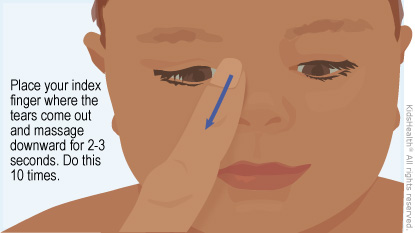Tears are made under the eyelids and drain through the tear ducts into the nose. When a baby is born with a blocked tear duct, the tears can't drain into the nose. The duct may be too narrow or have a web of tissue blocking it. The tears get backed up and come out the eyes. The eyes may get crusty and irritated.
If a blocked tear duct doesn't get better by the time a baby is 1 year old, an ophthalmologist (eye doctor) can do surgery to open the blocked duct.


1. Wash your hands with soap and water and dry with a clean towel. Be sure your nails are trimmed short.
2. Place your index finger where the tears come out and massage firmly downward for 2–3 seconds. Do this 10 times.


Can a blocked tear duct lead to other problems? Some blocked tear ducts get infected. This causes yellow or green mucus to drain from the eye, redness and swelling of the eye, and sometimes a fever. Health care providers prescribe antibiotics to treat tear duct infections.
How does the eye doctor open a blocked tear duct? There are different ways to open a blocked tear duct, including: